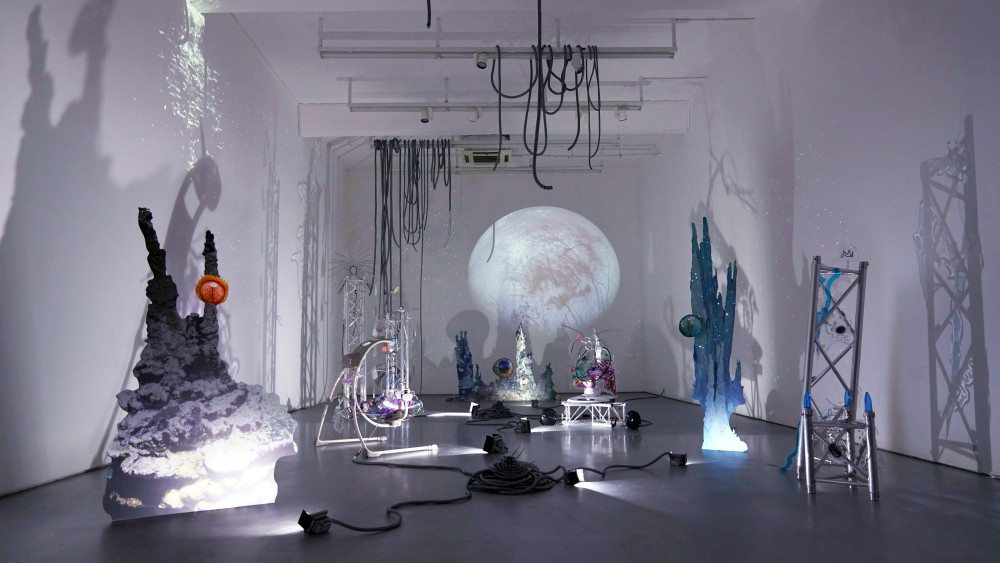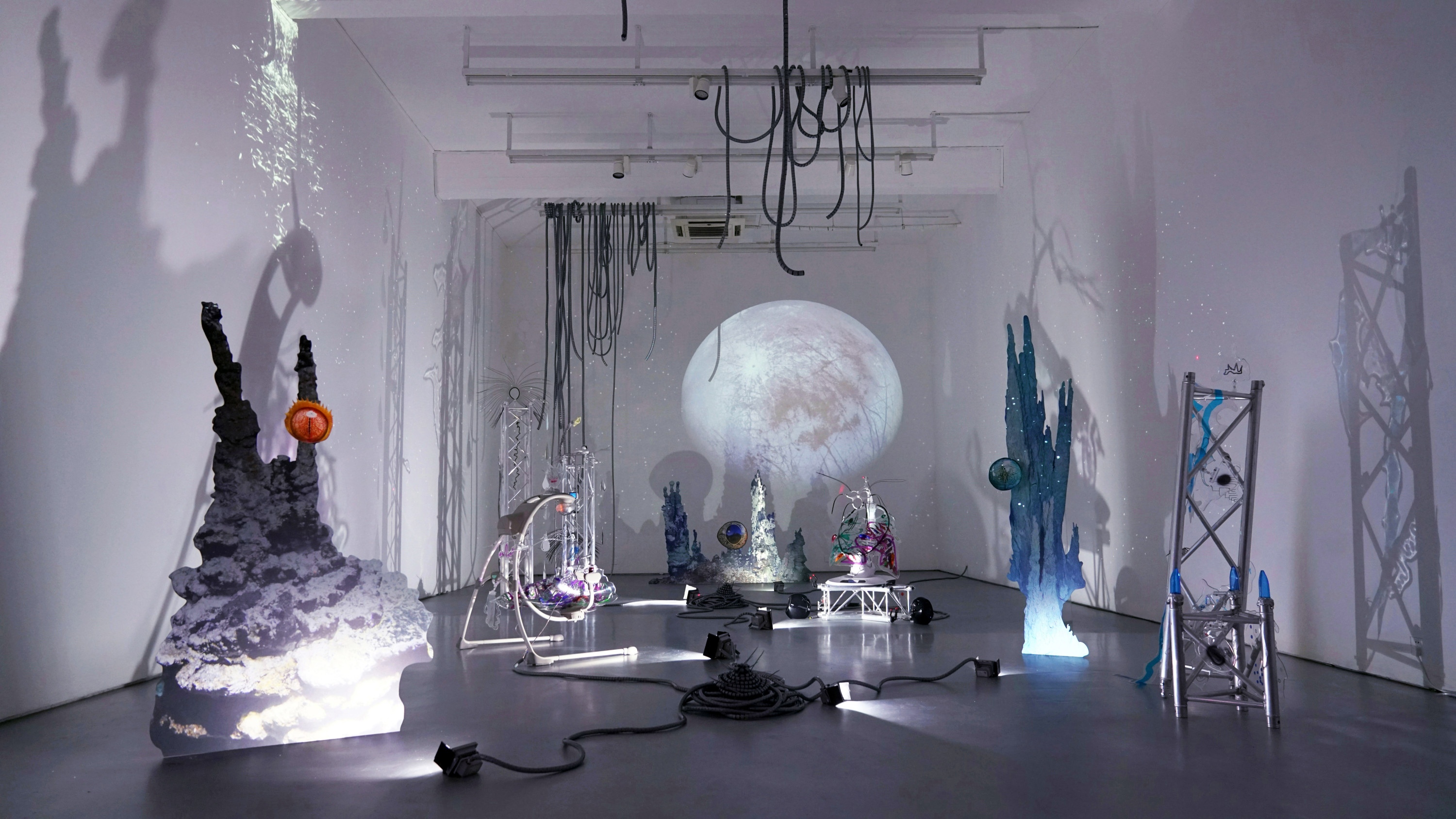'Loki's Castle', CC Foundation, Shanghai, 2017
-
selected works
View: ,installation views
View: ,Cc Foundation & Art Centre was proud to present Katja Novitskova: Loki's Castle the first institutional solo exhibition in China by Estonian artist Katja Novitskova, curated by Victor Wang.
In 1119 AD, author Zhu Yu published his Pingzhou KeTan (‘Pingzhou Table Talks’), detailing accounts of the trade, customs, social exchanges and early maritime technology used in China during the Song Dynasty. Notably, Pingzhou KeTan is the earliest written account of the use of a mariner's magnetic-needle compass for navigation at sea.[1]Outlining different maritime technologies, Yu also highlighted the importance of determining one’s location when navigating oceanic space, describing technologies that used samples of mud from the ocean floor, using a series of cables and hooks: by the appearance and smell of the mud, mariners could determine their whereabouts. [2]
889 years later, companies no longer need human-occupied submersibles or vehicles connected by cables to surface ships in order to explore the ocean floor. With the development of robotic autonomous underwater vehicles, or AUVs, wide swathes of undersea territory can be surveyed, for days at a time, with enough decision-making capacity to avoid collisions with the ocean floor terrain. [3]
Centering the exhibition Katja Novitskova: Loki's Castle was Novitskova’s installation Loki's Castle (2015), which visualised a new oceanic aesthetic and combining sound, moving image, sculpture and poetry to explore the deep-sea ecosystems on the ocean floor. First discovered in the late 1970s by scientists exploring a spreading oceanic ridge near the Galapagos Islands, these hydrothermal vents had created what some had described as an undersea gold rush for precious metals, genetic material, and fossil fuels, utilising data from the economic and scientific exploration of these deep-sea territories; these discoveries were fuelling robotic and scientific development and providing a new frontier for colonial industrial expansion. Novitskova created an immersive environment that hypothesises ‘current ontologies’ such as the potential genetic linkages between planktonic microbial communities and the maritime technologies used to excavate these hydrothermal communities.
What surprised scientists when they discovered hydrothermal vents were the large numbers of biological communities that surrounded them, which had never been seen before. These microbes are the foundation for life in hydrothermal vent ecosystems. Uniquely, instead of using light energy to turn carbon dioxide into sugar, as plants do, these microbes harvest chemical energy from the minerals and chemical compounds that spew from the vents—a process known as chemosynthesis. [4] With a variety of potential industrial applications, from pharmaceutical to mining, these new polysaccharide-producing microorganisms are expected to be utilised in many of these applications in the near future, and represent a growing interest for many sectors of industry. With favourable metals like zinc and manganese, as well as rare earth materials such as cobalt, already being mined for to use in high-tech devices from cell phones to computers.
Oceanic connectivity and thinking has long been an important base of knowledge, and a touchstone for many civilizations and cultures globally. It has also served as an important indicator and space of examination for scientists trying to provide statistical data on climate change: recent statistics show that there is a greater than 95 per cent probability that the current warming trend is the result of human activity since the mid-20th century, and is proceeding at an unprecedented rate. [5] This evidence is often achieved through a complicated marriage of corporate and scientific technological advances that have enabled scientists to see the big picture, collecting many different types of information about our planet and its climate on a global scale. This body of data, amassed over many years, reveals the signals of a changing climate.
Within Novitskova's installation industry and biology meet, mix and re-form anew, replicating the novel capabilities and chemical compositions within these microbiological communities that make them so commercially attractive, imagining the continuing diversity of expressions that these eco-systems may take in the near future. Novitskova, like other artists of her generation, visualises the new frontier and combining the many sub-currents that can be found intermingling under the high pressure, near-freezing temperatures and pitch-black darkness at the frontier of the deep ocean floor.
[1] Yongxiang Lu, A History of Chinese Science and Technology, 3 vols. (Berlin; Heidelberg: Springer, 2015), II, p. 288.
[2] Joseph Needham, Science and Civilization in China, Vol. 4: Physics and Physical Technology (Taipei: Caves Books Ltd, 1986), p.279.
[3] ‘Death of a Deep-sea Robot’, Physics Today (9 March 2010), available at: http://physicstoday.scitation.org/do/10.1063/PT.5.024143/full/. Accessed Feb. 8 2017.
[4] Lisa A. Levin et al., ‘Hydrothermal Vents and Methane Seeps: Rethinking the Sphere of Influence’, Frontiers in Marine Science (19 May 2016), available at: http://journal.frontiersin.org/article/10.3389/fmars.2016.00072/full. Accessed Feb. 8 2017.
[5] NASA, ‘Evidence’, in: Global Climate Change: Vital Signs of the Planet, available at: https://climate.nasa.gov/evidence/Accessed June 10 2017.

